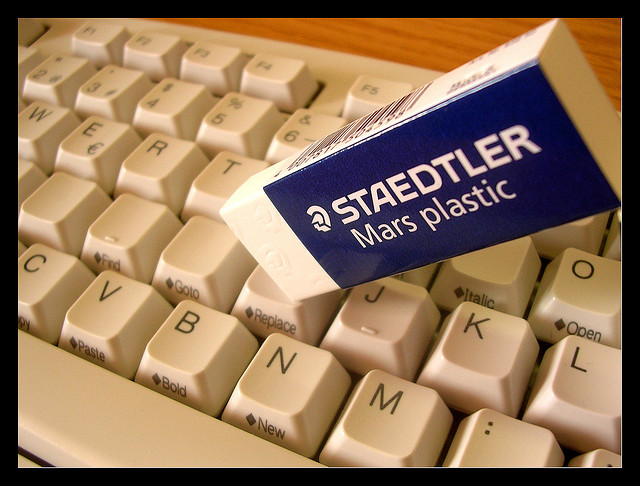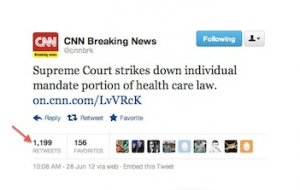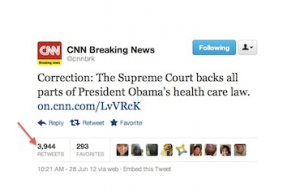Dealing with online errors and corrections

(photo: flickr/Jorge Felipe Gonzalez CC: BY-NC-SA)
Journalists and editors make mistakes no matter how careful they are. It’s standard to publish a printed correction when the error’s in a newspaper article. In the online world though, there’s less consensus on how to handle corrections and clarifications. Some media organizations simply make errors vanish by deleting them and clicking on the ‘update’ button. Others say that this isn’t enough and publishing a correction note is the only ethical option. onMedia’s Kyle James looks at best practices around correcting online errors and mistakes.
Making corrections is crucial
Getting things right and being transparent about our work are integral parts of being a journalist. If we are unconcerned about the accuracy of what we publish, we might as well be writing fiction. But we’re not. We’re recording and analyzing events and developments in the real world. We need to be as true to the facts as we can be.
But we’ll inevitably get something wrong at some point. Maybe it’s a small error, such as a misspelling of a name. It might be a little bigger, like an incorrect percentage in a business story. Or maybe it’s a huge error, like Rolling Stone magazine’s explosive article from Nov. 2014 about a rape on campus that fell apart under closer examination.
Good journalists and quality journalism outlets live and die by their credibility. If a serious news agency is seen as playing fast and easy with the truth, it’s likely to lose some of its audience.
It’s a violation of what Craig Silverman, the editor of the excellent and often funny blog Regret The Error, calls the “contract of correction,” which has existed between newspapers and readers for hundreds of years. This informal contract says that journalists will do everything they can to verify what they report and will correct errors as soon as possible and in a fair manner.
And surprisingly, admitting mistakes can make a media outlet appear more credible. A 1998 survey by the American Society of News Editors found nearly two thirds of newspaper readers “felt better” about a paper when they saw corrections.
Errors in the online world
The rise of digital and social media has brought a new set of issues around corrections and there’s still no real standard or approach to setting the record straight.
Some media organizations still question if pointing out an error in a story online is even necessary. Why not just correct it, hit the update button and keep quiet? Or, if a story is so riddled with errors or its very foundation is incorrect, why not just unpublish it, pull it off the page and pretend it never existed?
But while yesterday’s errors disappear with yesterday’s newspaper in the print world, the online world is more permanent. It can be very difficult, or even impossible, to completely delete wrong information posted on the web. Think of shared articles, cached webpages and screen shots. Errors, even those corrected soon after the fact, might have already traveled around the globe.
Social media presents even more chances for errors to spread like wildfire, making it hard to correct posts or tweets with errors in them once they’ve been shared a dozen or a thousand times.

Broadcasting giant CNN got in hot water when it put out incorrect information about an important US Supreme Court ruling on the air, online and on Twitter. It took the network 13 minutes to issue a correction of its first tweet, which by then had been retweeted more than a thousand times. Check out a full run-down of the fiasco here.
Some best-practice tips
Here are a few things to consider when it comes to rectifying wrongs at your own digital platform.
- Correct all factual errors in digital content as quickly as possible – although there is no time limit on making things right.
- When errors in digital content are found, add a clearly visible ‘correction note’ to the article to tell readers that the material was changed from a previously published version and give details about what was corrected. For example: “An earlier version of this article miscalculated the percentage rise in unemployment from 2013 to 2014. It should be 1.2 percent, not 2.4 percent as originally stated.”
- Think about proper placement of your correction note. If the error is serious, it might be good to displace the correction at the top of content. Otherwise, many online outlets place their notes at the end of the article.
- If it’s a simple typo or a grammatical error and correcting the error doesn’t alter the meaning of the story in any wy, it might not warrant a note. But almost everything else does.
- When corrections are made in a breaking news story where facts are emerging over time, be transparent about what you know, when you know it, and how you know it.
- Make it easier for audiences to point out possible mistakes in digital content. The Toronto Star puts a “Report an Error” link on most stories. But before changing digital content, any error reports from the public need to be verified.
- Avoid deleting an entire article by ‘unpublishing’ it if errors are discovered. It makes you seem like you’re hiding something. If there are major problems with a story, however, there may be legal reasons to take it down. Discuss this with editors and legal counsel and if a story is taken down, an editor’s note should explain why. (Rolling Stone magazine didn’t take down its widely discredited story on university campus rape. But they did put a long, four-paragraph explanation of the issues above the online version.)
- If erroneous information goes out via social media, audiences should be informed through those same channels as soon as the error is found. And, due to the nature of these platforms, it’s best to send out multiple correction tweets and status updates.
- Apply the same standards to all platforms – online, mobile, video and audio content as well as text.
- It might be worth considering a dedicated corrections and clarifications page (see what theguardian.com does for an example).
Written by Kyle James, edited by Kate Hairsine
RELATED ONMEDIA POSTS
How journalists can edit their own work
Online comments are being shut down





